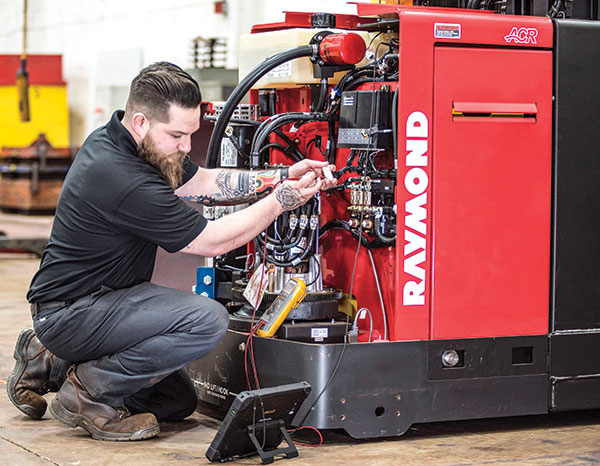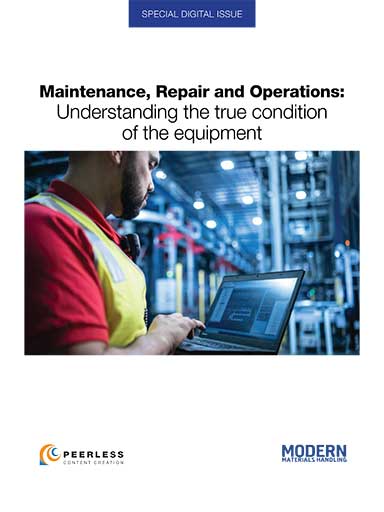Reader Survey: The great maintenance repair and operations (MRO) talent hunt
Yes, there are too few maintenance technicians. No, this doesn’t have the earmarks of an industry crisis. But it sure needs to be a priority of individual companies to hire and retain people capable of high performance levels.
Where did all the people go?
That’s got to be one of the most perplexing questions of our time.
Right now, more jobs need to be filled in the general workforce than there are people to fill them. Meanwhile, the Great Resignation is happening with several million people leaving their jobs month after month. I know of someone who has had four employers since early 2020 and has received raises each step of the way.
Yet, we consistently hear: “I can’t find anyone for this (these) position(s).” And that comment is made across the board, irrespective of industry and position. How can that be? How can every job be out of favor?
Some people fall back to the “we’re at or near full employment” argument. That might have some impact, but it’s also a bit abstract. Especially when it comes to maintenance technicians. So, we’re here to try and clean up some of the language and misperceptions about the current tech shortage.
We need more techs
Quite simply, the industry needs more techs for all types of equipment. It doesn’t matter whether the focus is techs for lift trucks or automated materials handling equipment. There just aren’t enough people right now.
Just ask Ron Fijalkowski, senior vice president of supply chain for SDI. “Absolutely, there’s a shortage of people,” he says. Furthermore, he has not seen instances of techs without plenty of work to do.
He goes on to say in that story that companies are doing their best to make techs more efficient on the job. Which is great, but how do companies become more efficient at finding enough of the right people in the first place? That is not a trivial question.
So, Modern Materials Handling asked its sister Peerless Research Group (PRG) to take a look at the state of technician availability and preparedness to work in the plant and warehouse. We also get some insights into top skills and salaries. There’s also the matter of finding and retaining technicians, which is where this conversation started.
How tough is it to hire techs, really?
No question. A large contingent of maintenance techs is working on materials handling equipment today.
Unfortunately, when we talk about the current shortage, we have a habit of talking like this: “I can’t find anyone. There’s no one out there.” But how true is that?
PRG wanted to know. So, they asked survey respondents how they assess their company’s ability to hire maintenance techs.
- 22% percent say, “We have a very difficult time hiring and retaining technicians.”
- 51% say, “It’s somewhat of an issue for us to find capable technicians.”
- 21% percent say, “It’s an issue, but a minor one that doesn’t impact our operations.” And finally,
- 6% percent say, “It’s not an issue at all.”
That’s a good start to quantifying how severe this problem really is.
How many is too few techs?
To what degree are applicants for entry-level technician jobs prepared to repair and maintain highly automated systems?
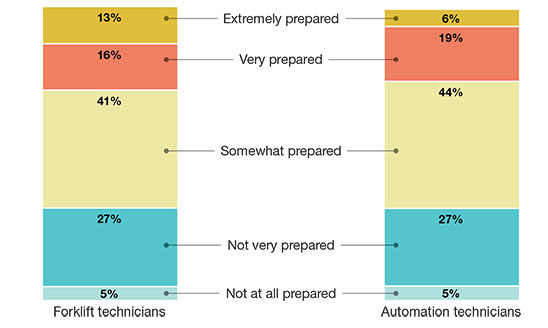
What problem(s) do you have hiring and/or retaining technicians?
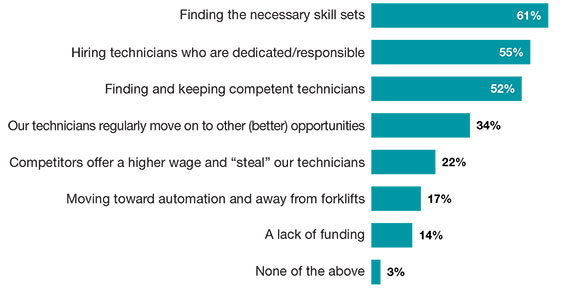
To help there, PRG asked people: “What is the estimated shortfall in forklift technicians in your company today?”
Just over half, 52% to be precise, say they are short one to five techs. Another 22% say they are short from 6 to 25 techs. Clearly, this second number is at good sized companies. PRG’s survey says 29% of respondents to the survey are at companies with revenues of $250 million and more.
No matter how you cut it, those shortfalls probably have an impact on maintenance programs at those companies. They are not as well off as the 13% of companies that say they have all the techs they need right now.
Unfortunately, the shortage of techs is a bit more acute when it comes to those who work on automated equipment. There, 59% say they are short one to five techs. Another 23% say they need six to 25 more technicians. And 9% have enough people today to work on automated equipment.
Let’s fast forward one year and five years. In other words, is the shortage of techs expected to get better or worse? As you already suspect: It depends.
In the short term, the expectation is that the lift truck tech shortage will get a bit worse, with 57% expecting to be short one to five people a year from now. That percentage is expected to drop to 46% in five years. Meanwhile, the number of companies expecting no shortage is expected to remain at 13% across the time frame of the survey.
When it comes to automated equipment, the expectation is for today’s 59% who are short one to five people to shrink only slightly to 55%. And respondents say this will not get any better in the next five years.
By the way, no one (yes, absolutely no one) says they will have enough automated equipment techs going forward. In other words, today’s 9% who have enough people don’t expect to be able to hold that going forward. That’s a problem.
Finding the right people
The next step is to figure out how prepared the people being hired are.
It’s a mixed bag for both lift truck and automated system techs. A third of all are considered to be “not very prepared” or “not at all prepared.” In reality, that might be the crux of the perception that the industry lacks techs in a big way. But there’s likely another issue here.
Forklift technicians shortfalls
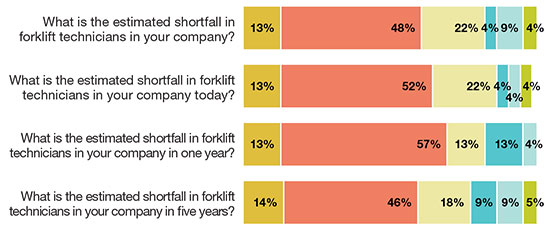
Supply chain automation technicians shortfalls
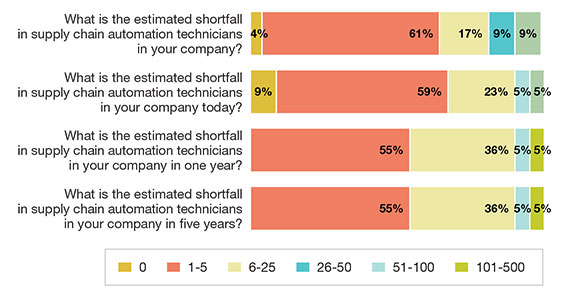
For the other two-thirds of all new techs, preparedness ranges from “somewhat” to “extremely.” The fact that only 13% of lift truck techs and 6% of automated techs are considered “extremely prepared” is probably not a great counterweight to the one-third of new hires who are barely ready if at all.
Clearly, “finding the necessary skill sets” is a huge issue and is cited by 61% of respondents as a problem in the hiring process. It is also the No. 1 hiring problem mentioned in the survey.
There are other issues, too. Fifty-five percent of respondents say its tough “hiring technicians who are dedicated/responsible.” And if that’s not a big enough hill to climb, 52% say finding and keeping competent technicians is also a problem.
Where training fits
The survey also asked about apprenticeships and training programs to bring along new hires with lagging skills.
There, 48% of companies have a structured training program or apprenticeship for forklift technicians. And for automated system techs, that number sinks to 26%.
Both numbers are probably low in relation to the number of new techs who arrive with deficient skills. But even that dichotomy doesn’t seem to be a powerful motivator to develop in-house training programs.
Instead, hiring managers much prefer training to be done before people arrive at their place of employment.
More than 90% are more likely to hire someone with a certification, which is worth more money at more than 80% of companies. And 82% say “individuals who have earned a certification perform at a higher level than those who don’t.”

But the value of certification doesn’t stop there. More than 90% of respondents say “an industry-standard certification (such as MSSC) is valuable for training new and incumbent workers.”
Skills and salaries
All of that said, there’s no question people are trying every technique they can imagine to find new techs. The top two are: hiring from other industries (42%) and working with community colleges to develop talent (38%).
About a third offer signing/referral bonuses, while 23% use career fairs. Outreach to the military (23%) is another popular strategy.
When the survey asked for a list of top skills hiring managers want, the list was extensive. They break down into two primary categories—attitude and skill sets.
The first includes: accountability, analytical, attention to detail, creative thinking, honesty, problem solving and responsibility.
Skill sets include what would be expected from electrical and mechanical to hydraulics, digital diagnostics and programming.
So what’s it all worth to the techs individually?
Indicate the degree to which you agree or disagree with the following
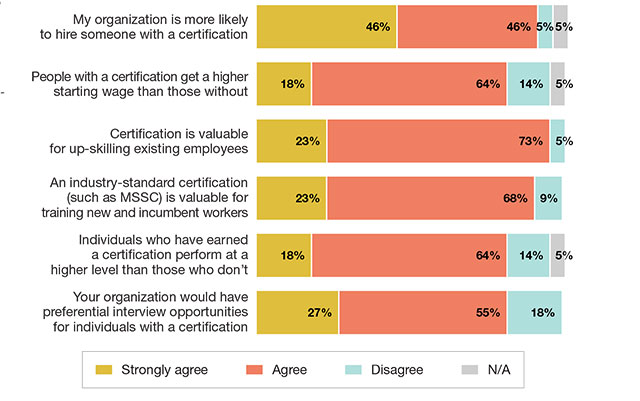
The survey says the base salary for lift truck techs is $46,400 with a top salary of $57,600. And for automation, the base is $49,900 with a top of $62,100.
Retaining maintenance technicians does remain a problem, with 34% of respondents saying their people do move on to other opportunities. And 22% cite higher wages as enough of a draw to another company.
As was said earlier, the shortage of technicians is an issue for lift trucks as well as automated systems. However, that condition is nuanced, and may not be as severe as some language tends to indicate.
Nevertheless, hiring skilled techs who will stay long term continues to be a challenge that requires thoughtful attention from hiring managers and others.


